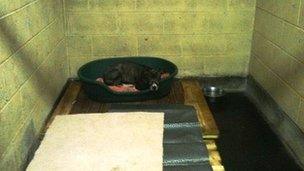Wales floods: Fire crews tackle problems after rain
- Published
Fire crews have tackled flooding in several areas of Wales after heavy rainfall overnight.
A driver was helped to safety after becoming stuck in flood water at Llanfynydd, Caergwrle, between Wrexham and Mold, on Monday morning.
Meanwhile, about 70 stray dogs had to be put on wooden pallets at North Clwyd Animal Rescue in Trelogan, near Holywell, Flintshire, after it flooded.
The Environment Agency has 11 flood alerts in operation in Wales.
A band of heavy rain hit the country on Sunday and forecasters predicted up to 40mm (1.5in) would fall in south Wales, with 50mm (2in) possible in some areas.
Local flooding is possible on both Monday and Tuesday.
Strong winds and stormy conditions are expected to spread elsewhere this week.
The Environment Agency said the wind and rain could lead to localised flooding from blocked drains and streams.
North Wales Fire and Rescue Service was called out at 09:40 BST to help the motorist in Llanfynydd.

About 70 stray dogs are affected at North Clwyd Animal Rescue
Crews have also dealt with calls about surface water in Deeside, Mostyn, Buckley and Mold.
In Monmouthshire, firefighters were called to properties in Mounton, Chepstow and Jordan Way, Monmouth, which had flooded due to blocked gullies.
Mid and West Wales Fire and Rescue Service dealt with two flooding incidents in Powys on Monday morning, involving properties in Llanbrynmair, near Machynlleth, and Welshpool town centre.
Flooding is also causing delays to train services in Wales.
Arriva Trains Wales said its Chester to Crewe, Shrewsbury to Cardiff, Shrewsbury to Holyhead, Shrewsbury to Manchester, Swansea to Cardiff and routes west of Swansea were all affected.
The train company urged travellers to use its online journey checker service to keep abreast of the situation.
The Environment Agency has 11 flood alerts, including in Pontblyddyn, near Mold, the Mawddach and Wnion catchment in Gwynedd, the rivers in the Ewenny and Vale of Glamorgan west catchment, and the rivers Llynfi and Ogmore in south Wales.
Other areas on alert include the Clwyd catchment from Clocaenog to Rhuddlan; the Upper Severn in Powys; Rossett (parts of the village near Alyn Bridge, including Station Road); Vyrnwy catchment (Afon Vyrnwy, Afon Tanat and Afon Cain and their tributaries); Conwy catchment, from Dolwyddelan to Conwy; Dyfi catchment (from Dinas Mawddwy and Llanbrynmair to the estuary, including Machynlleth); Alyn catchment (areas around the river Alyn from Llandegla to Rossett).
Wettest month
On Monday morning the agency said there had been a steady increase in river levels in south east Wales, but all were below the point of flooding.
Elsewhere in Wales, most rivers remained at or below normal levels, according to its website, external. River levels could also rise and driving conditions are likely to be hazardous.
Wales has just had its third wettest summer since records began in 1910, according to the Met Office.
The unseasonal weather led to the damage of hundreds of homes and businesses in Ceredigion in June, while a number of summer shows in Wales were cancelled in the weeks following.
The Met Office said June was the wettest month in Wales with 205mm of rain falling, compared to the monthly average of 85.8mm.
In July, 127.6mm of rain was recorded - the average is 92.6mm - while up the weekend so far this month 124.6mm had fallen, with the average of 107.4mm.
- Published24 September 2012
- Published24 September 2012
- Published31 August 2012
- Published13 July 2012